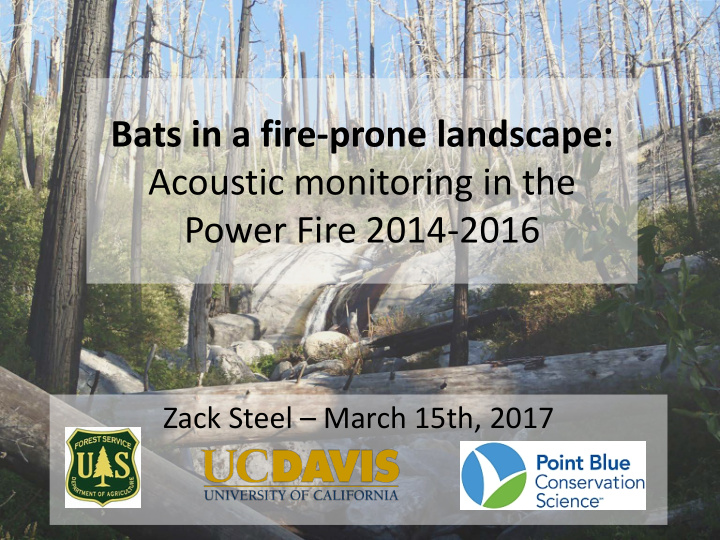



Bats in a fire-prone landscape: Acoustic monitoring in the Power Fire 2014-2016 Zack Steel – March 15th, 2017
Power Fire
Pallid bat Townsend’s big-eared bat Photo - Bat Conservation Photo - USGS International Fringed myotis Photo - USGS Western red bat Photo - USGS Silver-haired bat Photo – Explore Missouri Long-eared Myotis Photo - USGS Mexican free-tailed bat Small-footed myotis California myotis Photo – Ron Groves Photo - USGS Photo – Zack Steel
Bat survey methods Yuma myotis Photo - USGS Batmanagement.com Batmanagement.com
Acoustic surveys & echolocation askabiologist.asu.edu
Pass Classification Spotted bat Photo – factzoo.com
Long-legged myotis Photo – Wikipedia Pass Classification
Improved Acoustic Technology
Broad monitoring goals • Understand patterns of bat use in Big brown bat Photo - USGS Sierra Nevada forests • Understand how the bat community uses post-fire landscapes • Inform forest and wildlife management in Eldorado NF and the Sierra Nevada
Specific Questions / Monitoring Goals Burned vs. Unburned
Specific Questions / Monitoring Goals Burned vs. Unburned Burn Severity
Specific Questions / Monitoring Goals Unburned vs. • Species Richness burned • Species activity levels (passes/night) Burn Severity Unmanaged vs. managed
Survey Locations Sampling Category Locations Survey Nights May – Sept 2014-16 • Reference 10 128 ~2 week deployments • Low Severity 8 95 Surveys on alternating nights Moderate Severity 12 115 • High Severity – No management 9 97 High Severity – Reforestation 8 91 Total 47 526
Seasonality • Spring – arrive at summer habitats; establish maternal colonies. • June/July - Females give birth to 1 or 2 young, which become volant (can fly) ~ 1 month later. • Fall - Hibernate and/or migrate to winter habitats.
(Un)Burned forests - Richness
(Un)Burned forests – Activity Level Significant Difference
(Un)Burned forests – Activity Level Significant Difference
Effect of Burn Severity
Burn Severity - Richness
Burn Severity – Activity Level
Salvage Effects - Richness
Salvage Effects – Common Species
Salvage Effects – Rare Species Significant Difference
Take-home points • Having fire on the landscape is important to the full bat community • The variation of burn effects is also important with most species appearing to prefer areas of moderate effects (common historically) • ~10 yrs after salvage logging in Power there are few obvious effects Hoary bat Photo - USGS
Pallid bat Townsend’s big-eared bat Photo - Bat Conservation Photo - USGS International Future Directions • 2017 monitoring - focus on planned reforestation projects and habitat structure. • Complementary studies – Rim, Storrie, & Chips. Improved understanding of rare species habitat needs. • More sophisticated analyses: occupancy, seasonality, important covariates (e.g. distance to water)
Acknowledgements • El Dorado National Forest & University of California, Davis • Alissa Fogg, Josh Stagner, Jade Ajani, Tim Forrester, Hugh Safford
Questions?
Recommend
More recommend